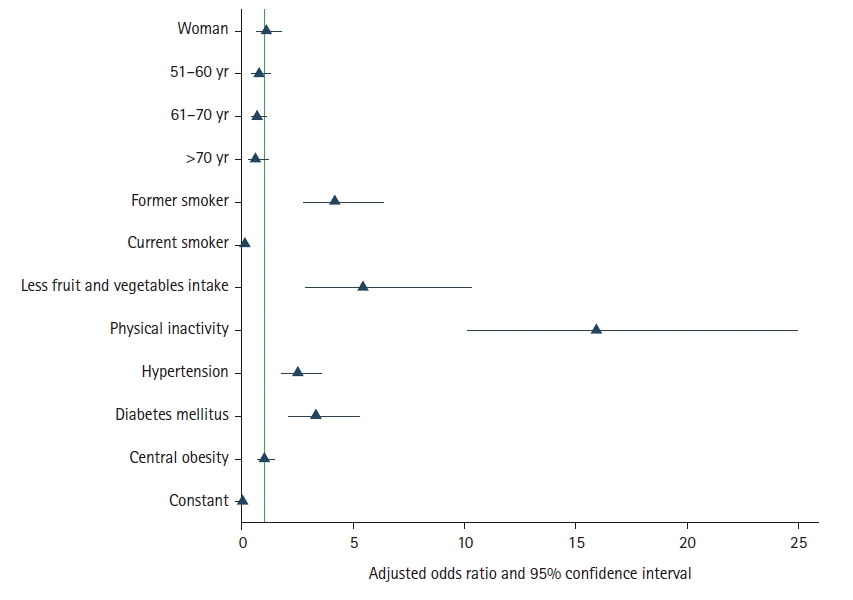1. GBD 2016 Causes of Death Collaborators. Global, regional, and national age-sex specific mortality for 264 causes of death, 1980-2016: a systematic analysis for the Global Burden of Disease Study 2016. Lancet. 2017; 390:1151–210.
2. GBD 2016 DALYs and HALE Collaborators. Global, regional, and national disability-adjusted life-years (DALYs) for 333 diseases and injuries and healthy life expectancy (HALE) for 195 countries and territories, 1990-2016: a systematic analysis for the Global Burden of Disease Study 2016. Lancet. 2017; 390:1260–344.
4. Maharani A, Praveen D, Oceandy D, Tampubolon G, Patel A. Cardiovascular disease risk factor prevalence and estimated 10-year cardiovascular risk scores in Indonesia: the SMARThealth extend study. PLoS One. 2019; 14:e0215219.
5. Authors/Task Force Members, Piepoli MF, Hoes AW, Agewall S, Albus C, Brotons C, et al. 2016 European guidelines on cardiovascular disease prevention in clinical practice: the Sixth Joint Task Force of the European Society of Cardiology and Other Societies on Cardiovascular Disease Prevention in Clinical Practice (constituted by representatives of 10 societies and by invited experts): developed with the special contribution of the European Association for Cardiovascular Prevention & Rehabilitation (EACPR). Eur J Prev Cardiol. 2016; 23:NP1–96.
6. Adisasmito W, Amir V, Atin A, Megraini A, Kusuma D. Geographic and socioeconomic disparity in cardiovascular risk factors in Indonesia: analysis of the basic health research 2018. BMC Public Health. 2020; 20:1004.
7. BPS-Statistics Indonesia. Statistical yearbook of Indonesia 2018. BPS-Statistics Indonesia; 2018.
8. Dewi FS, Choiriyyah I, Indriyani C, Wahab A, Lazuardi L, Nugroho A, et al. Designing and collecting data for a longitudinal study: the Sleman Health and Demographic Surveillance System (HDSS). Scand J Public Health. 2018; 46:704–10.
9. Nemeth R. Sampling design of health surveys: household as a sampling unit. LIS working paper series no. 358. Luxembourg Income Study; 2003.
10. Rose G, McCartney P, Reid DD. Self-administration of a questionnaire on chest pain and intermittent claudication. Br J Prev Soc Med. 1977; 31:42–8.
11. Hartopo AB, Fachiroh J, Puspitawati I, Dewi FS. Serum endothelin-1 level positively correlates with waist and hip circumferences in stable coronary artery disease patients. Rev Cardiovasc Med. 2021; 22:919–24.
12. Harbuwono DS, Pramono LA, Yunir E, Subekti I. Obesity and central obesity in Indonesia: evidence from a national health survey. Med J Indones. 2018; 27:114–20.
13. World Health Organization (WHO). WHO STEPS instrument for chronic disease. WHO; 2009.
14. Defianna SR, Santosa A, Probandari A, Dewi FS. Gender differences in prevalence and risk factors for hypertension among adult populations: a cross-sectional study in Indonesia. Int J Environ Res Public Health. 2021; 18:6259.
15. World Health Organization (WHO). The WHO STEPS surveillance manual. WHO; 2008.
16. World Health Organization (WHO). Global physical activity questionnaire (GPAQ) analysis guide. WHO; 2012.
17. Hussain MA, Al Mamun A, Peters SA, Woodward M, Huxley RR. The burden of cardiovascular disease attributable to major modifiable risk factors in Indonesia. J Epidemiol. 2016; 26:515–21.
18. Martiniuk AL, Lee CM, Lawes CM, Ueshima H, Suh I, Lam TH, et al. Hypertension: its prevalence and population-attributable fraction for mortality from cardiovascular disease in the Asia-Pacific region. J Hypertens. 2007; 25:73–9.
19. Yusuf S, Hawken S, Ounpuu S, Dans T, Avezum A, Lanas F, et al. Effect of potentially modifiable risk factors associated with myocardial infarction in 52 countries (the INTERHEART study): case-control study. Lancet. 2004; 364:937–52.
20. International Diabetes Federation (IDF). IDF diabetes atlas. IDF; 2017.
21. Shah AD, Langenberg C, Rapsomaniki E, Denaxas S, Pujades-Rodriguez M, Gale CP, et al. Type 2 diabetes and incidence of cardiovascular diseases: a cohort study in 1.9 million people. Lancet Diabetes Endocrinol. 2015; 3:105–13.
22. Lee IM, Shiroma EJ, Lobelo F, Puska P, Blair SN, Katzmarzyk PT. Effect of physical inactivity on major non-communicable diseases worldwide: an analysis of burden of disease and life expectancy. Lancet. 2012; 380:219–29.
23. Anderson L, Oldridge N, Thompson DR, Zwisler AD, Rees K, Martin N, et al. Exercise-based cardiac rehabilitation for coronary heart disease: Cochrane systematic review and meta-analysis. J Am Coll Cardiol. 2016; 67:1–12.
24. Agency of Health Research and Development (Indonesia). Indonesia basic health research (RISKESDAS) 2018. Ministry of Health (Indonesia); 2018.
25. Arnett DK, Blumenthal RS, Albert MA, Buroker AB, Goldberger ZD, Hahn EJ, et al. 2019 ACC/AHA guideline on the primary prevention of cardiovascular disease: a report of the American College of Cardiology/American Heart Association Task Force on Clinical Practice Guidelines. J Am Coll Cardiol. 2019; 74:e177–232.
26. Wu Y, Qian Y, Pan Y, Li P, Yang J, Ye X, et al. Association between dietary fiber intake and risk of coronary heart disease: a meta-analysis. Clin Nutr. 2015; 34:603–11.
27. Arsyad DS, Westerink J, Cramer MJ, Ansar J, Wahiduddin , Visseren FL, et al. Modifiable risk factors in adults with and without prior cardiovascular disease: findings from the Indonesian National Basic Health Research. BMC Public Health. 2022; 22:660.
28. Teo KK, Ounpuu S, Hawken S, Pandey MR, Valentin V, Hunt D, et al. Tobacco use and risk of myocardial infarction in 52 countries in the INTERHEART study: a case-control study. Lancet. 2006; 368:647–58.
29. Lv X, Sun J, Bi Y, Xu M, Lu J, Zhao L, et al. Risk of all-cause mortality and cardiovascular disease associated with secondhand smoke exposure: a systematic review and meta-analysis. Int J Cardiol. 2015; 199:106–15.
30. Mons U, Muezzinler A, Gellert C, Schottker B, Abnet CC, Bobak M, et al. Impact of smoking and smoking cessation on cardiovascular events and mortality among older adults: meta-analysis of individual participant data from prospective cohort studies of the CHANCES consortium. BMJ. 2015; 350:h1551.
31. Pearce N. Analysis of matched case-control studies. BMJ. 2016; 352:i969.






 PDF
PDF Citation
Citation Print
Print



 XML Download
XML Download